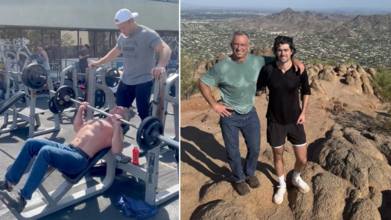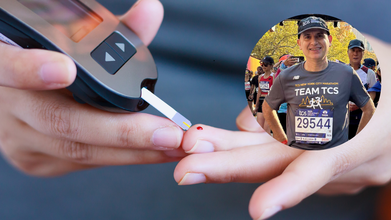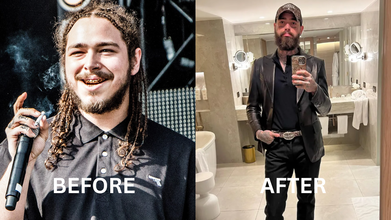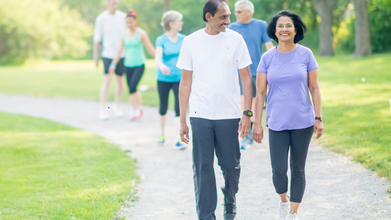- Health Conditions A-Z
- Health & Wellness
- Nutrition
- Fitness
- Health News
- Ayurveda
- Videos
- Medicine A-Z
- Parenting
RFK Wears Jeans On A Hike And To Gym, Why Is It A Bad Idea?

Credits: X
Robert F. Kennedy Jr., the U.S. Health Secretary and a well-known fitness enthusiast, has become the center of a new controversy. This time, it is not over policy, but his workout attire.
Kennedy was recently spotted hiking up Arizona’s Camelback Mountain in a pair of dark blue jeans on a scorching 107°F day, as reported by The Guardian. Photos of him drenched in sweat while climbing in a T-shirt and jeans quickly went viral, prompting both admiration for his stamina and concern for his sartorial and safety choices.
Kennedy, known for his unconventional stances on various health issues, has developed a pattern of working out in jeans.
Whether it’s hiking, lifting weights, or even wading into creeks, he seems committed to denim regardless of the activity or weather conditions.
While some fans praised his grit, others questioned the health implications of exercising in such restrictive clothing, especially given that the Centers for Disease Control and Prevention (CDC), which falls under his department, advises people to wear "loose, lightweight, light-colored clothing" during extreme heat to avoid heatstroke and other complications.
Why Denim Isn’t Built for the Gym
While Kennedy’s denim devotion has captured public attention, fitness experts and health professionals advise caution when it comes to choosing workout attire.
Here’s why jeans aren’t the best choice for physical activity:
Restricted Range of Motion
Jeans are typically made from thick, non-stretchy fabric, which can severely limit mobility during exercise. Movements required in activities like squats, lunges, and even basic stretching become difficult, which not only reduces workout effectiveness but may also increase the risk of injury.
Personal trainer Justin Kraft, speaking to Newsweek, pointed out that restricting motion can be harmful, especially for those with pre-existing conditions like high blood pressure or sciatica.
Low Breathability and Overheating
Unlike moisture-wicking fabrics found in gym wear, denim traps heat and sweat. In hot weather or high-intensity workouts, this lack of breathability can lead to overheating, discomfort, and even heat exhaustion. The Guardian noted that Kennedy hiked during record-breaking Arizona heat, despite warnings from the CDC about dressing appropriately in extreme temperatures.
Chafing and Skin Irritation
Chafing is a common side effect of exercising in jeans. The seams and heavy fabric can rub harshly against the skin, particularly in areas like the inner thighs, leading to painful rashes or abrasions.
Not Designed for Functionality
While jeans might offer some resistance, experts say there are better alternatives for those looking to add intensity to workouts. Weighted vests, resistance bands, slam balls, and other functional gear provide added challenge without compromising comfort or safety..
Run To Heal: How A 56-year-old NYC Teacher Ran To Reverse His Diabetes

Credits: iStock, PEOPLE
A New York City teacher Pedro Soto, 56, who teachers at the Manhattan school had a simple sore throat and he believed it was from a viral infection, but it soon turned out to be type 2 diabetes.
This was in April 2024, when he went to his doctor with the complaint of a sore throat and took a blood test. This is when he was "officially diagnosed with type 2 diabetes".
In an interview with PEOPLE, he tells while the doctor recommended medications for him, he was determined to make a lifestyle change first. "After receiving the news, I chose not to start medication right away. Instead, I committed to exercising, running twice a week and improving my diet."
Turns out, running, changed his life.
Running With Diabetes: Soto's Determination To Change His Life(style)
Pedro Soto first considered running the TCS NYC Marathon after a colleague mentioned that her husband had completed it. Motivated, he applied through a special program for teachers, sharing an essay about his type 2 diabetes diagnosis. His story earned him a spot on the team. As he trained, he closely monitored his health, undergoing regular blood tests every three months. The improvement surprised him. His blood sugar levels, once concerning, gradually returned to the normal range. While type 2 diabetes cannot be fully cured, it can be reversed, and Soto was seeing that transformation firsthand.
Training Through The Tough Times
The marathon was scheduled for November 2, 2025. Soto’s training, however, didn’t begin smoothly. In June, he learned he had Lyme disease. Around the same time, he lost his father. Because of these back-to-back challenges, he wasn't able to train consistently until August. Running soon became more than exercise. It became a way to navigate grief and rebuild strength.
He describes those months as emotionally heavy. Running offered him space to reflect, heal, and feel close to his father. It became a ritual that allowed him to confront his feelings rather than avoid them.
Experiencing the Race
To prepare mentally, Soto dove into YouTube videos and articles about the marathon. Still, nothing compared to the real thing. To him, race day felt like a citywide block party. The cheering crowds, music, and energy made the pain more bearable. He said that although the long hours of pounding take a toll on joints and muscles, the city's encouragement kept pushing him forward.
Finding Strength in His Students
The toughest stretch came in the final six miles, when self-doubt crept in. What kept him going was thinking about his students. Soto works with teenagers in a transfer program, many of whom have struggled in traditional school systems. Their perseverance inspired him. If his students could show up every day despite their challenges, he believed he could finish the race.
He says he is taking care of his health and this itself is an act of commitment to his students. Whenever he feels healthier, he shows up as a strong educator and for him the marathon teaches him the importance one needs in life of balance, self-care, and knowing when to put themselves first.
How Post Malone Lost 55lbs Just By Cutting Soda And Ditching Junk

Credits: Canva
"I'm excited for this next chapter in my life, I'm the happiest I've ever been, and for since I could remember I was sad," said Post Malone as he talked about his journey of losing 55 pounds. He went from 240 lbs to 185 lbs, he revealed at The Joe Rogan Experience Podcast. His inspiration? His daughter. He said that he is focused more on his health since becoming a father.
"It is definitely made me take better care of myself. I want to be around to see her go and do kick-*ss stuff. And before, you know, I was really drinking a lot and smoking a lot and stuff. I kind of took everything and toned it down a little bit and, you know, doing my best and really got my weight going," he said.
His weight loss journey started after he welcomed his daughter in May 2022, and on April 20233, he shared on his Instagram that post becoming a father he is now prioritizing his health.
How Did Post Malone Lose So Much Weight?
He said it is simple, he decided to "kick soda and start eating better". He also is trying to cut down his smokes and brews or give up completely, which is taking time.
On his Instagram post, he wrote: "I've had a lot of people ask me about my weight loss and I'd suppose, performance on stage. I'm having a lot of fun performing, and have never felt healthier. I guess dad life kicked in and I decided to kick soda and start eating better so I can be around for a long time for this little angel. Next up is smokes and brews, but I like to consider myself a patient man... lol!"
While his fans were initially concerned about his weight loss, he reassured them that his "brain is in a super dope place" and he was "the happiest" he has ever been in a long time.
When he made his appearance in June 2024, on The Joe Rogan Experience Podcast, he said that his fans in fact, thought, that he started using drugs, due to his drastic weight loss. This is why he posted on Instagram to deny those allegations. “I remember, whenever I started losing my weight, everybody was like, ‘Hey, this is what meth looks like,’ and I started dancing on stage and having fun and having more energy and just enjoying life again, you know what I mean,” he told host Joe Rogan. “Like I mentioned, I was s***** for a long time, but I had my baby and I’m in a great f****** spot and then the first thing that happens is like, ‘Oh he’s on f****** drugs.’"
However, Malone has confirmed that he is not "any hard drugs".
What Helped Malone Lose 55 Pounds?
In an appearance on The Howard Stern Show in October 2023, Malone said that he has not been on weight loss medication, rather he is now making better food choices.
Earlier, whenever he was on tour, he would go for junk, but now, he has made a deliberate choice to eat "grilled chicken" "carrots" with a "little bit of white rice with hot sauce". He said he was blown away to find out that hot sauce has no calories.
He also shared that he has cut out fried food and pizza. He shared that he would previously eat a lot of junk while on tour, especially because those places were open at 2 am after a show. However, when he made those small dietary changes, he lost 20 pounds, which made him think "let's keep building".
He also shared that he started cutting down on his soda intake. However, he would occasionally reward himself with one after a show.
He also showed off his weight loss in an August 2023 Instagram post on a mirror selfie and wrote: "Introducing Viceroy Chungus VonBattlepass, i love you," in caption.
Cannot Hit 10,000 Steps A Day? A Short Stroll Too Could Make You Healthy

Credits: Canva
For years, the idea of walking 10,000 steps a day has been treated like universal fitness wisdom, however, a recent study reveals that even a short stroll too could help you stay healthy.
From fitness trackers to morning-walk groups, the number has been repeated so often that many people believe it is a scientifically proven rule. The truth is far simpler and far more encouraging. New research shows that you do not need anywhere near 10,000 steps to improve your health. In fact, even a small amount of regular movement can dramatically lower your risk of heart disease and early death.
What Recent Research Reveals
A new study published in the British Journal of Sports Medicine examined how step counts influence longevity and heart health, particularly in older adults. The findings were surprisingly optimistic. Scientists discovered that walking as few as 4,000 steps in a day, even if you manage this number only one or two days a week, can reduce the risk of death by 26 percent. It can also lower the risk of heart disease by 27 percent when compared to those who barely moved.
The benefits became even more striking when participants achieved the 4,000 step target on more than three days per week. In that group, mortality dropped by more than 40 percent and the risk of heart issues fell by 27 percent. These numbers show that moderate, regular walking has powerful protective effects on long-term health.
How Many Steps Do You Really Need
The study also explored whether aiming for higher step counts brings additional benefits. Researchers found that walking around 7,000 steps a day provides a slight extra advantage when it comes to living longer. However, it does not significantly change cardiovascular outcomes. This means that hitting 4,000 steps is already enough for meaningful protection, especially for older adults or people who are unable to reach higher counts.
Interestingly, the study also revealed that the number of days you walk matters far less than the total steps collected throughout the day. When scientists adjusted for total daily steps, the link between how many days people walked and their health results disappeared. The real takeaway is this: what matters most is how much you move overall, not whether you meet a daily or weekly quota.
Why Consistency Matters More Than Intensity
Walking is one of the simplest forms of movement, yet its benefits are remarkably wide-ranging. It is gentle, low impact and accessible to almost everyone. Regular brisk walking has been shown to improve heart health, support weight management, boost mental well-being and improve mobility. These improvements occur because consistency helps the body adapt, even when the total effort seems small.
For older adults, or for anyone returning to activity after a long pause, this consistency is especially important. Small, steady efforts accumulate and gradually build up stamina. Over time, this reduces the risk of chronic disease and enhances overall fitness without stressing the joints.
Tips To Make Walking A Sustainable Habit
If you want to enjoy the health benefits of walking, the key is to stay consistent rather than chase big numbers. A few practical tips can help you build a routine that feels realistic and enjoyable.
Start slowly
If you have been inactive for a while, begin with five to ten minutes of walking at a comfortable pace. Gradually increase your duration and distance over several weeks. This prevents strain and reduces the risk of giving up too soon.
Set achievable goals
Aim for manageable targets such as walking 20 to 40 minutes three days a week. Once this feels comfortable, you can add more time or increase your frequency if you wish.
Adjust your routine when life gets busy
If you are traveling or have long work hours, try breaking your walks into shorter chunks. A few five to ten minute walks throughout the day can help you stay on track.
Do not let the weather stop you
When outdoor conditions are not ideal, choose indoor spaces such as malls, gyms, community centers or even long corridors at home or work.
Add variety to your routes
Different routes help fight monotony and make walking more enjoyable. Rotate between parks, neighborhoods or indoor spaces to keep things fresh.
© 2024 Bennett, Coleman & Company Limited

